Everyone knows Athens, but not the Athens Riviera so much. The Athens Riviera, which offers good opportunities, especially between May and November, is an area that leaves a great impression on me in every sense. Beautiful and natural beaches, delicious food, calmness, and sublime nature, in addition to the absence of traffic, make for a wonderful holiday.
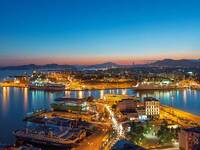 Starting from the Port of Piraeus, where a Poseidon temple is located, and stretching all the way through Cape Sounion, The Athens Riviera consists of a 65 km long coastline. If you start from Port of Piraeus by car and follow the coast, you can cover this winding road in an hour and a half. You can swim at every point and eat good food along this route. If it’s not July or August, you won’t encounter traffic.
Starting from the Port of Piraeus, where a Poseidon temple is located, and stretching all the way through Cape Sounion, The Athens Riviera consists of a 65 km long coastline. If you start from Port of Piraeus by car and follow the coast, you can cover this winding road in an hour and a half. You can swim at every point and eat good food along this route. If it’s not July or August, you won’t encounter traffic.
Magnificent views are guaranteed. After you leave Piraeus, residential areas start to leave their places for beaches. The Athens Riviera is a very nice summer holiday option. I will talk about the first 25 km part of the 65 km coastline, where people from Athens come to eat and have fun. The remaining 40 km of the coastline is for those having a longer holiday in one of the many summer residences.
The first important place in the Riviera is Glayfada, followed by Voula, Vouliagmeni, Vari, and Varkiza. If you’re someone who likes to eat, being on the Riviera will give you pure joy as you’ll be able to taste delicious dishes with different presentations and tastes.
DOURAMBEIS
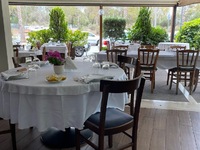 Dourambeis, located on the west of our route, is a seafood restaurant founded in 1932 the very near Microlimano. It’s still run by the same family who found it. The second and third generations of the family work together to run the place now. Unlike other restaurants in the region, Dourambeis is not located by the sea; in fact, it doesn’t even have a view of the sea. However, it’s well known by the locals, and although it’s a big restaurant, it’s packed most of the time, especially on the weekends.
Dourambeis, located on the west of our route, is a seafood restaurant founded in 1932 the very near Microlimano. It’s still run by the same family who found it. The second and third generations of the family work together to run the place now. Unlike other restaurants in the region, Dourambeis is not located by the sea; in fact, it doesn’t even have a view of the sea. However, it’s well known by the locals, and although it’s a big restaurant, it’s packed most of the time, especially on the weekends.
Dourambeis has an open-air terrace as well as a closed area. Their wine and ouzo menus are rich. Two things about this place particularly caught my attention. The first one was the special oven in the kitchen, and the second was the quality of its service and its waiters. A waiter, by its meaning, is the person that waits for you at your table. They are supposed to stay at a distance from the table to give privacy, but they’re always in your eyesight. They don’t serve but always observe if you need anything at any given moment. When you raise your head to ask for something, they come closer and ask what you need. Then, they go inside for a few seconds, convey your need to the server, and the server brings your ask.
According to a British tradition, there’s a runner that complements the waiter and the server. The runner cleans up the table. If there’s a sommelier, they take your wine order and do your refills. These four roles, waiter, server, runner, and sommelier, make up a good restaurant service, which in these times are very rare to encounter.
At Dourambeis, there is a waiter, a server, and a runner. These three levels of staff ensure that we get great service which complements our dining pleasure. The most interesting and important aspect of Dourambeis is its kitchen. I’ve never seen anything quite like it, and neither have they anywhere else. There’s a stove in the kitchen that is 4 meters long and one meter high, and its body part is made up of several layers of metal. On top of it, there is a thick volcanic rock. A fire, provided by natural gas, enters the furnace from several places, and a temperature of 2000 degrees Celsius is created inside. This heats the volcanic rock to cook food. An attendant carefully opens the covers of the stove and checks the fire. The temperature on the surface of the stove is not the same everywhere, something they specifically regulate. A few chefs cook fish and other seafood on this stove.
There are also old-style hand-held wire grills, some of which reach one meter in diameter. If a sea bass that weighs 6 kilos will be cooked, they cut the fish in half into two fillets, one on the bone, put it on the stove, and cook on the volcanic rock. Small grills are used if they’re going to cook two or three shrimps. The juices coming out of the cooked ingredients flow over the volcanic rock with an inviting sound, and the beautiful smell of the food spreads around. I think this technique makes a difference in taste.
In Dourambeis, it’s possible to come across flavors you haven’t tasted before. I tried a small monk fish grill here that I haven’t tried elsewhere before. They place 10 small monk fish with bones, each about the size of a shrimp, on the stove and cook shortly without adding anything else. The result is delicious. There are also different shrimp styles, freshwater crayfish, and other Aegean fishes that are cooked with this style. Another nicety about this place is the tomatoes on top of a huge table at the entrance. These tomatoes, which they grow themselves, taste so delicious that I got the taste of an August tomato in November. Before you start your dishes, they bring you some of these tomatoes along with some salad. They prepare your meal while you’re busy with your salad. You have the risk of being full early if you get your hands on the bread, so it is better to stick with the salad.
PAPAIOANNOU
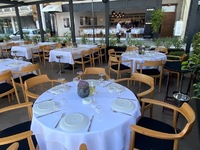
Pour a little bit of olive oil on the oven tray and place the fish fillets skin side up. At the thickest point of the fish, insert a toothpick until it reaches the bottom. Measure the depth of the fish using the toothpick and multiply the centimeters by 4.
This will tell you how many minutes the fish should be cooked at 200 degrees Celcius in a turbo oven.
So, if the thickness is 3 cm, the cooking time is 12 minutes. This is the way they cook fish at this fine restaurant.
With great sea views and efficient service, you will enjoy many local starter dishes before your line catches fish.
ITHAKI
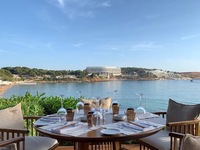 Ithaki is a restaurant with several chefs from different cultures because there are great Japanese, French and Italian dishes on the menu. Greek dishes are fusion versions of classical dishes. As you may know, there’s feta cheese in Greek Salad.
Ithaki is a restaurant with several chefs from different cultures because there are great Japanese, French and Italian dishes on the menu. Greek dishes are fusion versions of classical dishes. As you may know, there’s feta cheese in Greek Salad.
Some restaurants grate it, some add it to the salad in a single piece, and some serve it by dividing the cheese into small pieces.
In Ithaki, however, they’ve made a foam out of feta cheese. This restaurant is located by the sea and has comfortable armchairs.
They have an extensive wine and drinks menu. It’s a bit more expensive than the other restaurants in the area. You can find all kinds of fresh fish in this place, and they’re delicious. They have different interpretations of cooking fresh fish and vegetables. I really like their cauliflower tempura with white truffles grated on top. Sea bass also has fresh black truffles.
This restaurant, where they can serve up to 100 people at a time, is close to the Four Seasons Hotel.
MATSUHISA
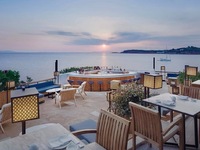 Matsuhisa is the name of the founder of world-famous Nobu restaurants. Matsuhisa Nobu lived in Peru for many years and learned the cuisine well. Then, he created a fusion of Japanese and Peruvian cuisines. In 1987, he opened a restaurant with his first name in Los Angeles and became very successful. The famous actor Robert de Niro, who loves this restaurant, offers Matsuhisa to open a new place together, and the first branch of Nobu opens in New York, this time using the chef’s surname. Matsuhisa Nobu wants Nobu to be a different brand and keeps running his original Matsuhisa too. You can see Matsuhisa branches in a couple of places around the world, and one of them is located in the garden of the Four Seasons Hotel in Athens. Located on a peninsula, the hotel overlooks a wonderful bay. I think it’s one of the best Four Seasons hotels on the seaside. Matsuhisa has no affiliations with the hotel. It’s a high-quality restaurant that faces west, allowing you to watch the sunset. Matsuhisa Nobu has brought his right-hand chef to Athens, practically channeling all his power here. Don’t come to Athens Riviera and think you should not eat Japanese food. Definitely spend an evening at Matsuhisa’s beautiful bar sometime between May and October, watch the sunset and taste the great food.
Matsuhisa is the name of the founder of world-famous Nobu restaurants. Matsuhisa Nobu lived in Peru for many years and learned the cuisine well. Then, he created a fusion of Japanese and Peruvian cuisines. In 1987, he opened a restaurant with his first name in Los Angeles and became very successful. The famous actor Robert de Niro, who loves this restaurant, offers Matsuhisa to open a new place together, and the first branch of Nobu opens in New York, this time using the chef’s surname. Matsuhisa Nobu wants Nobu to be a different brand and keeps running his original Matsuhisa too. You can see Matsuhisa branches in a couple of places around the world, and one of them is located in the garden of the Four Seasons Hotel in Athens. Located on a peninsula, the hotel overlooks a wonderful bay. I think it’s one of the best Four Seasons hotels on the seaside. Matsuhisa has no affiliations with the hotel. It’s a high-quality restaurant that faces west, allowing you to watch the sunset. Matsuhisa Nobu has brought his right-hand chef to Athens, practically channeling all his power here. Don’t come to Athens Riviera and think you should not eat Japanese food. Definitely spend an evening at Matsuhisa’s beautiful bar sometime between May and October, watch the sunset and taste the great food.
BLUE FISH
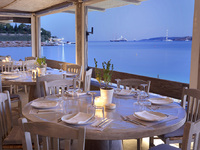 Because the riviera’s coastline is fairly jagged, some restaurants look to the west, and some look to the east. The ones that look west offer you peerless views of the sunset. Those that look east, however, can offer you a great glimpse of a full moon rise when it’s that time of the month. Blue Fish is on the water and has a sunset view.
Because the riviera’s coastline is fairly jagged, some restaurants look to the west, and some look to the east. The ones that look west offer you peerless views of the sunset. Those that look east, however, can offer you a great glimpse of a full moon rise when it’s that time of the month. Blue Fish is on the water and has a sunset view.
In addition to the very Greek starter dishes, the way they serve fresh line-caught fish here is rather unusual. Say you are a party of four. You may choose a fish of around 3 kg from their display on the ice. They separate the fish into three different parts. They slightly boil the head and take the flesh off the bones, including the cheeks and mix it into a Greek-style pasta dish and serve as the first course. Then, they take a whole fillet off the bone, divide it into big chunks, and serve them seared with a special sauce as the second starter. Then, they grill the remaining fillet on the bone juicy and serve it on the bone as the main course with some virgin olive oil sauce.
All these courses are combined with a perfect “baby” spinach salad on the side. It is advisable to start with this 4-course bonanza and be patient to order the small Greek dishes later, depending on the appetite left.
For the desert, do not order anything but cross the street to an ice cream parlor called “Bufalo Gelato” to eat a custom-made ice cream plate with fresh fruits and nuts of your choice on top of the buffalo milk or vegan ice cream of your choice. The only down side is you will never enjoy other ice cream plates anywhere else anymore.
AKTI
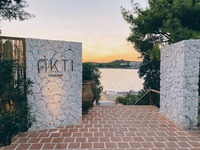 Akti is a nice fish restaurant by the sea. It’s also located in Vouliagmeni, close to the Blue Fish, and serves Greek cuisine along with international dishes. It has three different areas: closed, open, and semi-open. Open space is ideal.
Akti is a nice fish restaurant by the sea. It’s also located in Vouliagmeni, close to the Blue Fish, and serves Greek cuisine along with international dishes. It has three different areas: closed, open, and semi-open. Open space is ideal.
Business people go to Akti for lunch, and people from Athens fill the place in the evenings. It has its own beach. A Greek friend of mine had taken me there for lunch before, and I left very pleased then, so I went a couple of times with other friends again. We made reservations for 9 p.m. and when we arrived, the place was almost empty.
People started to come in around 10 PM when we were halfway through our dinner. After 10 PM, the place became very crowded very quickly, and a DJ performance began. Everyone seemed to have a lot of fun; apparently, after midnight, the place turned into a Greek-style all-hands-in-the-air kind of party. They also do happy hour dining with a DJ from 4 pm on weekends.
KASTELLORISO
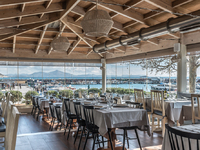 This restaurant got its name from one of the Greek Islands, Meis. The cuisine of this island makes up the menu of Kastelloriso. Us foreigners may not be able to distinguish between regional tastes, but the Greeks can tell that difference. Along with Greek dishes, some restaurants have added dishes from different countries as well to their menu to meet the requests of summer residence owners. They make dishes that we can find as standard everywhere in their own way, and they are proud of that.
This restaurant got its name from one of the Greek Islands, Meis. The cuisine of this island makes up the menu of Kastelloriso. Us foreigners may not be able to distinguish between regional tastes, but the Greeks can tell that difference. Along with Greek dishes, some restaurants have added dishes from different countries as well to their menu to meet the requests of summer residence owners. They make dishes that we can find as standard everywhere in their own way, and they are proud of that.
It’s easy to make choices from the menu at Kastelloriso because each dish includes a description as to where the ingredient comes from. Much delicious seafood, such as sea urchin, and tiny shrimps, are available on the menu. Here, you can also find a fish cheek plate made from the cheeks of big fish. Adorned with comfortable wooden tables, Kastelloriso serves nonstop from midday to midnight.
VARKIZA YACHT CLUB
Varkiza Yacht Club takes its name from the town it’s located in. Don’t be misguided by its name, Varkiza Yacht Club isn’t very stylish. It’s a fisherman’s shelter with a cool name where people who live in Varkiza moor their sail boats. You can see similar yacht clubs along the Athens Riviera.
This yacht club has a beautiful public beach that is about 1 km long. People take their towels, umbrellas, and beach chairs to enjoy the sea and then eat. Some tables are right on the shore where the sea meets your feet.
You can taste everything found in Greek taverns here. The monk fish is also very good here. In most kitchens, monk fish is made either roasted or as a soup. You get 250 grams of meat from a kilo of the ugly monkfish. Since it’s a fish with a lot of wastage, it’s cheaper than other fish. I like to grill monkfish. Once you get the insides of the fish cleaned and get the two filets, ask for the remaining waste. Add a little bit of water to this wastage, cook for 15 minutes and drain the hard parts off - et voila! - you have a delicious clear soup in your hands. Grill the filets in the oven following the 4 cm rule. This is how they cook this fish and call it “poor man’s lobster.” It really does taste like lobster.
